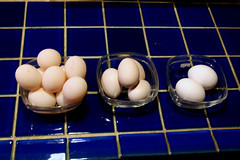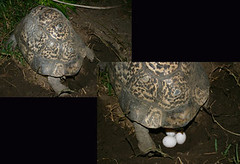Tuesday, November 22, 2005
so-red
How can it be? It's winter! Damn! I miss the smell of flowers and the buzz of the bugs.
Birds still visit my yard - mostly sparrows and finches. I tried to entice a scrub jay to come down from his tree with a carrot - but he thought I was nuts.... "What do you mean a carrot. I want a peanut!"
California has seasons just not as dramatic as having snow. In the San Gabriel Valley you can watch snow come and go with the rain... it rains down here and the snow drapes on the mountain. I love and miss the flowers...
The Gingko tree is bright yellow and that's wonderful. I sweep the leaves and sprinkle them about the front of my yard between the bushes. The contrasting yellow on the ground is beautiful. I hate throwing away leaves. It is still not cold enough to have killed off the frantic yellow jackets.... they are a nuisance.
The crickets are still singing here and there. I miss them at night in winter. I have some of this wonderful red Delphinium cardinale - a member of the Ranunculaceae family. They are six feet tall and love the dry weather of California. My blue Delphinia continued to bloom until last week...
The best thing about winter are the cool nights..... the short days, the lack of crickets, the few birds, the grey skies.... nah!
Sunday, November 13, 2005
eggs
Ernestine, the leopard tortoise had another batch of eggs...
Ernestine's eggs from last night are on the left. Miss Chicken's are in the middle. And the right two eggs are from the market and they are Large Grade AA.
It is cool outside right now at night. The sun makes the day warm and the tortoises bask. But, last night Ernestine broke through her cage and started digging a hole with her back feet to deposit her eggs.
Ernestine had found a spot of just dirt and she started to dig in it with her long back claws. The soil is dry so she urinated in it to make the soil easy to dig. Ernestine has a huge capacity so the area was as wet as if I had poured a quart of water at her rear.
For three hours she dug and finally she put her head in and pushed hard. Her tail wagged and a clear mucus dripped and then her first egg appeared. It seemed as if this was not only a Herculean effort, but a painful one at that. The egg dropped slowly into the wet soil of the six by 12 inch hole. Each egg was wrapped in this clear mucus that allowed the egg to touch down slowly on the others without a sound. The egg shells are similar to chicken eggs except when the mucus is removed they are more porous.
After the ninth egg she was so tired. She tried to close up the hole but it was around 52 degrees F outside at 10 p.m. and so I decided to bring her inside. I put her in the sink and filled it with warm water. Her eyes were sunken from dehydration and I hoped she would drink as she normally would do. She kept moving her legs as if she was still outside trying to fill the hole with her eggs.
Ernestine does not have a mate and so her eggs are sterile. In the same way as Miss Chicken lays sterile eggs because she, too, does not have a mate. Miss Chicken has several 'times' a year when she is ready to lay eggs. Her personality changes and she does this little dance when I come close to her - I suppose she sees me as her 'mate.' Miss Chicken 'chucks' at the kitchen door to be let in and then finds her spot. She will spend approximately an hour laying her one egg. Ernestine, on the other hand lays many eggs all at once.
Inside Ernestine's egg is very much like Miss Chicken's egg. There is a white and a yolk. Some people like to eat turtle eggs.... like those who like chicken eggs. Sometimes it is hard for me to eat one of Miss Chicken's.... I don't think I can eat Ernestine's..... I will stick to tomatoes and almonds and other plant materials ....
Ernestine's eggs from last night are on the left. Miss Chicken's are in the middle. And the right two eggs are from the market and they are Large Grade AA.
It is cool outside right now at night. The sun makes the day warm and the tortoises bask. But, last night Ernestine broke through her cage and started digging a hole with her back feet to deposit her eggs.
Ernestine had found a spot of just dirt and she started to dig in it with her long back claws. The soil is dry so she urinated in it to make the soil easy to dig. Ernestine has a huge capacity so the area was as wet as if I had poured a quart of water at her rear.
For three hours she dug and finally she put her head in and pushed hard. Her tail wagged and a clear mucus dripped and then her first egg appeared. It seemed as if this was not only a Herculean effort, but a painful one at that. The egg dropped slowly into the wet soil of the six by 12 inch hole. Each egg was wrapped in this clear mucus that allowed the egg to touch down slowly on the others without a sound. The egg shells are similar to chicken eggs except when the mucus is removed they are more porous.
After the ninth egg she was so tired. She tried to close up the hole but it was around 52 degrees F outside at 10 p.m. and so I decided to bring her inside. I put her in the sink and filled it with warm water. Her eyes were sunken from dehydration and I hoped she would drink as she normally would do. She kept moving her legs as if she was still outside trying to fill the hole with her eggs.
Ernestine does not have a mate and so her eggs are sterile. In the same way as Miss Chicken lays sterile eggs because she, too, does not have a mate. Miss Chicken has several 'times' a year when she is ready to lay eggs. Her personality changes and she does this little dance when I come close to her - I suppose she sees me as her 'mate.' Miss Chicken 'chucks' at the kitchen door to be let in and then finds her spot. She will spend approximately an hour laying her one egg. Ernestine, on the other hand lays many eggs all at once.
Inside Ernestine's egg is very much like Miss Chicken's egg. There is a white and a yolk. Some people like to eat turtle eggs.... like those who like chicken eggs. Sometimes it is hard for me to eat one of Miss Chicken's.... I don't think I can eat Ernestine's..... I will stick to tomatoes and almonds and other plant materials ....
Ernestine
Ah, poor Ernestine. I have looked after her since 1987 when she was the size of a grapefruit. I think that leopard tortoises, Geochelone pardalis, are so beautiful. I bought Ernestine from a pet store whose owner adored tortoises, too. She introduced me to her vet who to this day still comes to look after the menagerie.
Ernestine in action... HERE
Leopard tortoises need to be warm in the sunlight and have access to water - they love to sit in both. When I moved to Ohio these requirements were difficult to adhere to but the house in Ohio had old fashioned radiators under the kitchen sinks. So, I would keep Ernestine in a black plastic cement mixing container on the counter. She also had a light to increase her exposure beyond what we had in the more northern latitude.... and so Ernestine grew.... and grew.
One fateful day, Ernestine now a full 18 inches long and almost 20 pounds, felt she needed to get out of her confinement.
My young daughter and a friend sleep beneath over in the basement in a room for guests beneath the kitchen. In the dark of morning they heard what they thought to be rain falling but, instead they awoke to find the ceiling tiles floating in a foot of water in the basement. They got up in a panic to find water coming down the walls and the stairs ..... Up they rushed to find Ernestine had slipped out of her cement mixing bucket and into the kitchen sink. She had tried to get out of the sink and had turned the hot water on her self. By the time we all saw the deluge, the water was cold... but Ernestine had burned herself quite badly.
The vet in Ohio had me give Ernestine anti-bacterial injections because her neck, her front legs, and her back legs were swollen and smelled of infection. Flies started to infest under her shell but one of the other smaller tortoises kept an eye on the maggots and followed Ernestine about for small snacks. Eventually, Ernestine healed but the scutes on her upper carapace fell off.
How big do leopards tortoises grow? Well, in 1993 I traveled to South Africa, where these reptiles are from. I was standing next to my hosts near an open field near the back brush. Down below in a clearing I spotted something about 3/4 mile away that looked very familiar. I yelled. "it's a tortoise!" and ran down the hill with a small crowd behind me not understanding my glee. I found a small coffee table sized female leopard tortoise which, could have weighed over a hundred pounds.... and out from the bushes around her were four or five males - around 25 to 30 pounds. I brushed her back and found a few ticks the size of the end of my thumb attached to the soft part of her carapace between the scutes. She never flinched as I touched her. Wonderful!
Saturday, November 05, 2005
Ephydridae and Chalcididae

Looking at sticky trap after sticky trap full of so many insects I get very 'antsy'.... sorry.... Funny thing, the 280 8x8 inch sided sticky traps are different from the 280 sticky traps from last year and the year before and the year before that.... What is the difference? Well, this spring had a large storm event that took out a large portion of the Mugu Lagoon habitat. It probably caused changes in the upper watershed that flows into Mugu. There are different genera and families this year. There are many more individuals as well.
Why would something so devastating like the spring 2005 storm event cause so much change? ~ More families, more species more numbers???? Also, there seems to be more parasitoids and hyperparasitoids. This Chalcid wasp (on the right) seems to be stuck on traps in large numbers with even larger numbers of Phoridae.... Are Phoridae parasitized by Chalcids??? (The fly on the left is an Ephydridae a very salt tolerant Diptera)
Sticky traps are like trying to understand ecology in the La Brea Tar Pit style.... When 'A' falls in and gets trapped in the tar pit (sticky trap), it may have been chased by 'B' which, when stuck is attacked and killed by 'C' which is then eaten by 'D'... The difference between digging bones out of the tar pits and identifying insects mushed on sticky traps are different exercises.... oh my aching eyes...
Please note that the larger fly is only 2 mm .... and that there are wasps a quarter the size of this particular Chalcid!!!!
Subscribe to:
Comments (Atom)


